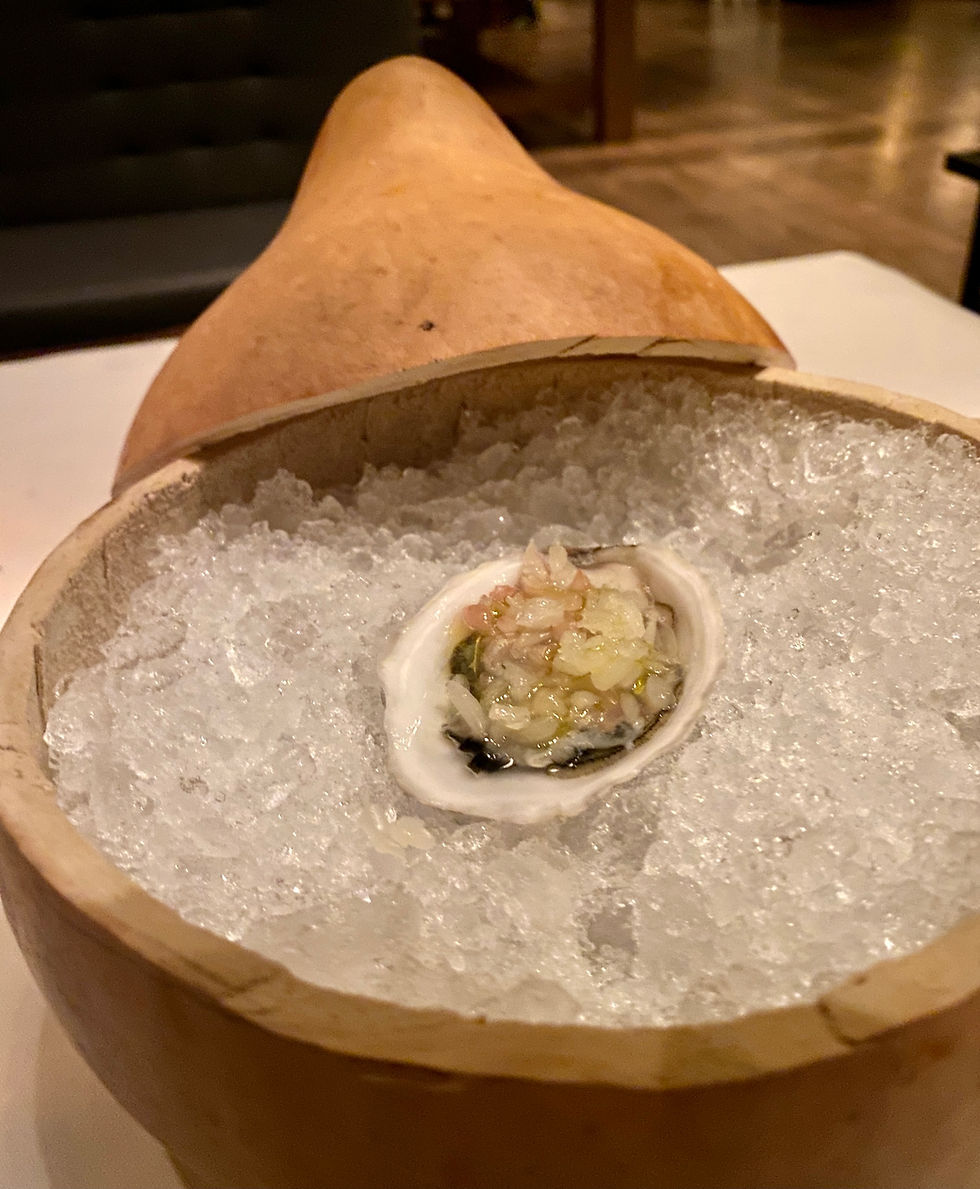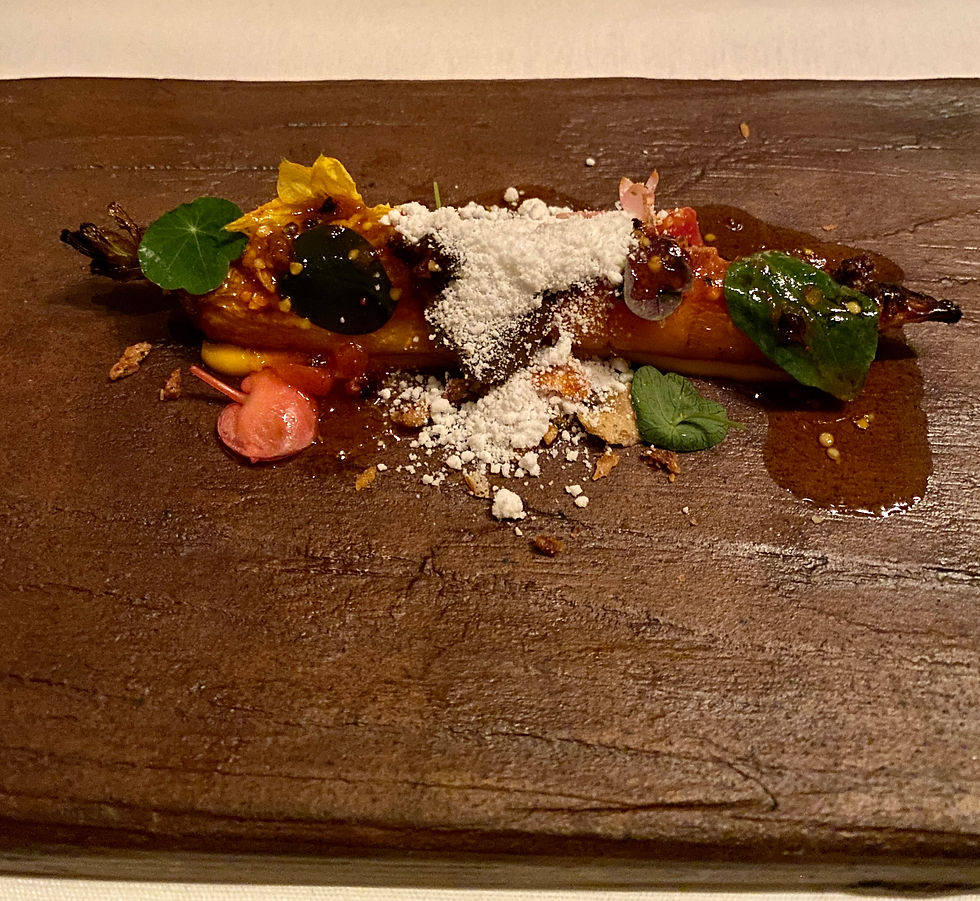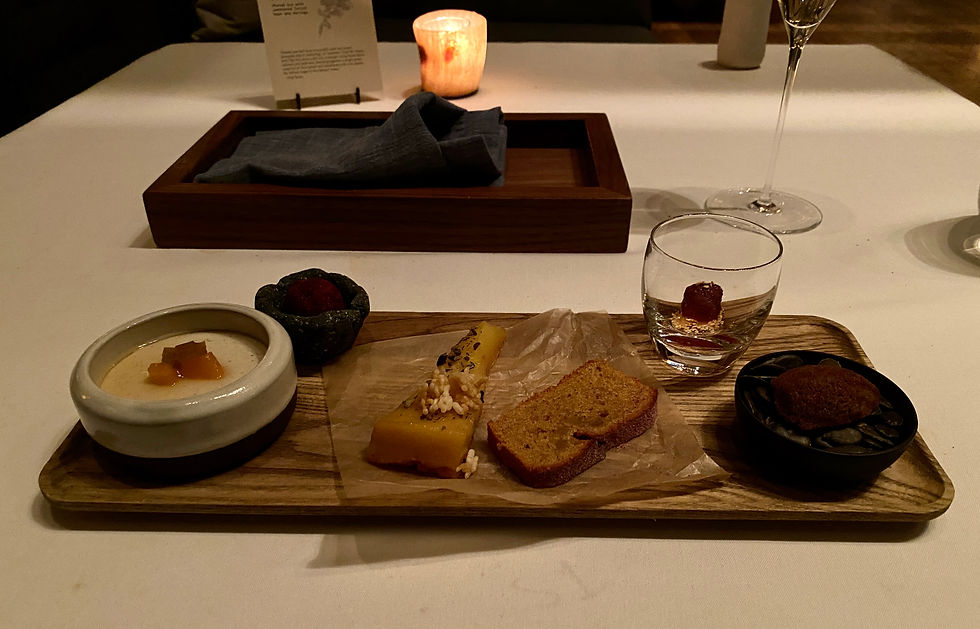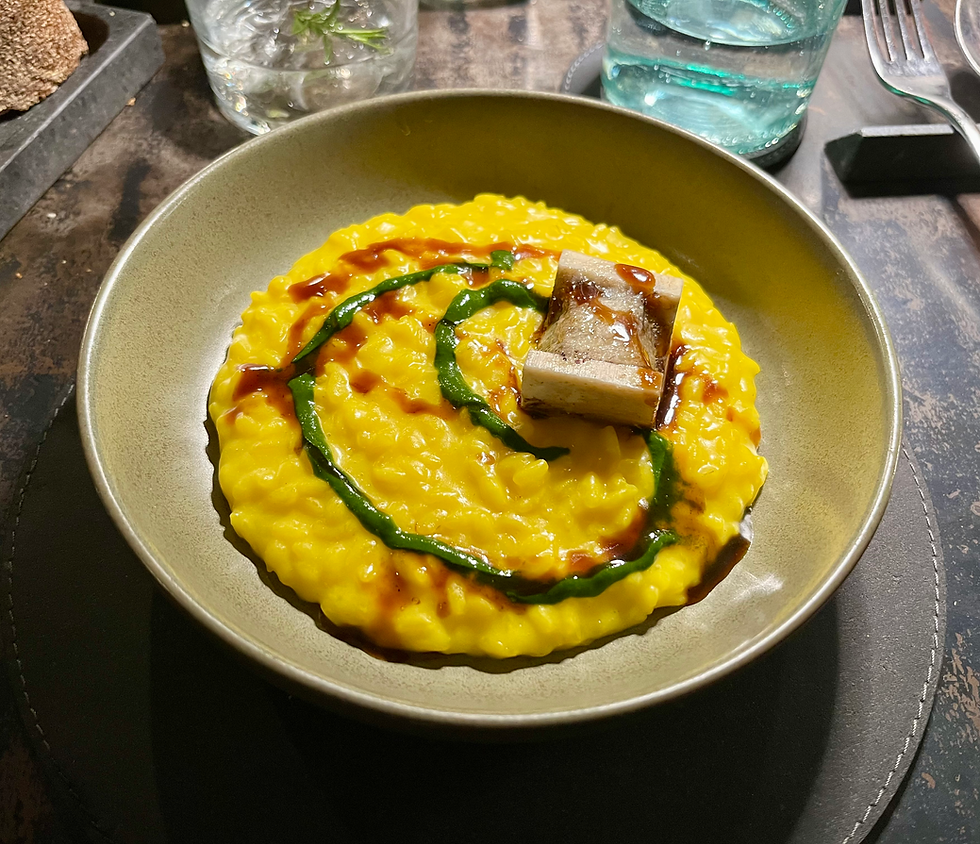Chef Shola Olunloyo in Residence at Stone Barns – Pocantico Hills, NY
- the_maestro

- Feb 8, 2021
- 17 min read
Updated: Apr 26, 2021
"What we want to eat is, on the hierarchical scale, superior to what we want to do."
- Yoruba Proverb
I had no intention of being anywhere except Charlotte on the evening of February 6th. I was perfectly content after six weeks of travel to stay put in my apartment, especially with these new variants of the virus rearing their ugly heads. But sometimes, life hands you something that you can't ignore.
I sat beside a young chef/fellow foodie and his significant other in NYC at Sushi Noz almost exactly a year ago, and in a sochu-fueled disarmament of my normally shy self with strangers, I added them both on Instagram. I really enjoy his food posts, and live vicariously through them, since he gets to enjoy the greatest NYC culinary gems on the regular. Charlotte might have some good food, but it's not a food city like New York.

About a month ago, this new foodie friend wrote on Instagram about his excitement to have secured a reservation for a meal at Stone Barns, the same Stone Barns that houses Dan Barber's culinary temple Blue Hill at Stone Barns, which I visited last February and changed the way I think about food. This time, however, the kitchen would be featuring the cuisine of Nigerian chef Shola Olunloyo.

It seems that in response to the pandemic, once indoor dining resumed in New York State, Stone Barns decided to host four chefs in their kitchen over the first several months of 2021 to combine their unique perspectives with the unbelievable bounty of the Stone Barns farming complex, calling the series "Chef in Residence at Stone Barns." The focus is on chefs that represent communities most affected by the hardships of the pandemic. Chef Shola was the first to be featured. This same fellow foodie posted last weekend his photos of the meal, declaring it was a meal that "moved [him] significantly" and was one of the best meals he had enjoyed in a very long time.
Something like that I just can't ignore––this dude knows more about food than pretty much anyone else I know, and for him to make that endorsement certainly turned my head. To this day he is still posting photos of his experience, saying he "still think[s] about this meal." And Chef Shola isn't that easy to access. He works primarily as a private chef, while also doing sporadic work at his Studiokitchen in Philly. Combine that with a culinary tradition with which I was wholly unfamiliar, despite that Nigeria is home to over 200 million people, and it was really hard to close my browser and stop looking for last-minute flights to the northeast.
Here's the other piece of magic––when I looked online, of course, there were no seats for a solo diner available, which is all the more common these days, to my sadness and frustration. So I emailed Stone Barns, and the only reservation they could offer me was the last night of Chef Shola's residency, February 6––and this happened to be exactly one year after my first dinner at Stone Barns. I couldn't pass up that level of serendipity. I felt, somehow, I was "meant" to be there that night.
Chef Shola was born in the UK and raised both there and in Nigeria. As a young chef, he crafted a self-styled "apprenticeship" for himself, traveling much of the world, including southeast Asia, and soaking up various culinary traditions. He came to the U.S. and generated a stir in the Philadelphia dining scene, mostly with his popups and private chef dinners. Since then, he has opened his modernist and experimental Studiokitchen project where he applies modern techniques to west African cuisine and ingredients. This man, however, does not have a restaurant, so his food is difficult to access if you don't have private chef-level money.

Most Americans have little experience with the cuisine of West Africa, or Africa in general, and I am no exception. Before this meal, I knew almost nothing about Nigerian cuisine, and what little I did know came from researching Chef Shola. What a shame for us to have such a woeful grasp of the cuisine of the seventh-largest country in the world, home to one of the largest, most vibrant metro areas in the world (Lagos), and the largest population in Africa! This interview with Splendid Table is a great way to get to know Nigerian cuisine and Chef Shola's world.
After a sleepy 6AM flight and a sunny afternoon in the city eating a sidewalk lunch at one of my favorite casual spots in the East Village (post coming soon!) and enjoying the exhibits (and views) at the Whitney Museum, I made the hour-long drive up to the Hudson Valley to take my seat in the old Rockefeller estate dairy barn that is now the main dining room on the Stone Barns property. With at least 20 feet of space between the very few tables in the spacious barn, I felt very comfortable and safe and was very excited to begin my meal, enjoying the various kinds of West African music being played gently over the speakers.

Because of the lack of familiarity American diners have with African foodways, little cards were provided with each dish to explain the ingredients and inspiration. When I sat down, a card was waiting for me with Chef Shola's words:
"In Nigeria, food is the focal point of every celebration, as much for nourishment as for joy. This menu centers the cultural foodways at the heart of Nigerian community––and also integrates the knowledge and technique from my personal journey as a chef through Southeast Asia, East Asia, Europe, and West Africa.
The menu is not competing with tradition, it's an evolution of tradition."

The service this time was much more down-to-Earth than the crew in charge of my experience when I last visited, and Hannah, my beverage sherpa, poured a hibiscus tea verjus with pink peppercorn to welcome me. It was refreshing and tasty, and I was rather thirsty after walking around the city in the winter air and being on my feet at The Whitney.
Evan, my (adorable) server welcomed me back, and we nerded out about food and wine throughout the night. Seeming to detect my ravenous foodiedom, he asked how adventurous I was feeling, to which I responded "I'll eat anything but balut." He said "yeah, I'm with you there" and whisked away to bring me my first bites.
1) Tradition, reinterpretation.
A large bowl with an African woven basket lid was placed before me and opened, revealing three small bites meant to represent street food you might find on your average busy corner in Lagos. The first was a take on suya, perhaps the apotheosis of Nigerian street food consisting of a skewer of grilled beef dusted in a peanut- and spice-based condiment. This version was loosely consistent with that tradition, with cubes of raw Stone Barns beef on a cracker garnished with locust bean shoyu (soy sauce), peanut, and lemongrass. The second was a fritter of kidney beans from the Hudson Valley, another staple of Nigerian street food called akara (which also appears in Brazilian cuisine, evidence of a pathway of foodways from enslaved peoples in West Africa being brought to Brazil in the colonial era) which was garnished with a condiment of preserved habanada peppers. Last was my favorite––a take on Nigerian "pepper soup" made with spiced carrots from the Stone Barns farm and a powder made from guinea pepper and ginger leaves. Delicious and nourishing, and perfect to warm up on a chilly February evening.

A giant gourd was brought out next, inside which was a Northeastern oyster garnished with calamansi, cardamom, and pomelo. Refreshing and complex, and a perfect palate cleanser to begin the meal.

2) Peanut.
"I wanted to begin the menu from the ground up––potatoes and peanuts are essential crops. While peanuts grow in the ground, they rise up to the heavens in Nigerian food culture. Peanuts are like the caviar of Africa, and the peanuts grown here at Stone Barns are delicious. When I first visited, I ate all the peanuts in the car before I got back to Philly."
I can confidently say I have never started a meal with ice cream, but here was a little wooden bowl and wooden spoon housing a potato ice cream with pickled peanuts from the farm. Peanuts are everywhere in Nigerian cuisine, and Chef Shola calls them "the caviar of Africa." Here, peanuts from last season's harvest were pickled for nearly a year in anticipation of Shola's residency, providing a glorious tang to slice through the creamy potato, and on top there were toasted Benne seeds and Benne seed oil, which added an otherwise nutty component.

Right after the ice cream was cleared away, I ordered a Shola-inspired cocktail from Hannah, which was a sort of daiquiri with green mango and koji, a type of fungus used in Japan to saccharify various starches, which added a savory component that brought forth both the potato and peanut from the previous dish and allowed to flavors to linger on the palate. Good pairing, Steven! And what a beautiful presentation!

3) Carrot.
"Carrots are everywhere in Nigerian cuisine, but mostly as a garnish for jollof rice or stews. They were never the main attraction, so I wanted to put them at the center of the plate here."
Carrots are a staple of Stone Barns' produce, and they produce some of the most magnificent carrots I've had, and an incredible variety. Two small carrots were grilled and served with a mélange of wonderful flavors, including oca root (type of tuber, like a potato), curry spices, powdered coconut, and various nuts and grains. Inside the dish were little flavor bursts of pickled carrot for acidity. The carrots were, of course, the best you can find, and the flavor combinations in the dish displayed spectacular complexity and depth, along with a lingering heat. Evan looked at my wiped-clean plate and said "I don't think I have ever seen anyone eat every single thing on the carrot dish before."

Hannah poured a permutation of sauvignon blanc from Domaine Pelle, a Loire Valley producer from Menetou-Salon, a lesser-known neighbor of Sancerre. Just like a good Sancerre, it was clean, grassy, and mineral-driven, which was exactly what the spices in the carrot needed to shine.

4) Iru.
"This dish is inspired by the locust bean. In West Africa, it is both a pivotal food ingredient and an income-generating commodity that primarily benefits the women who harvest the beans.
Iru, fermented locust bean paste, is a traditional condiment with unmistakable umami flavor. In the last 50 years, foreign food companies have replaced it with factory produced bouillon cubes. My mission is to bring fermentation back."
One of the traditional condiments of Nigerian cuisine was next, in an absolute doozy of a dish that I will remember for a long, long time. I watched Dan Barber, the Blue Hill chef, taste this condiment for the first time on his Instagram, and say to Shola, laughing: "That is the most delicious thing I have ever tasted." Iru, a paste made from the fermented seeds of a tree native to West Africa, commonly called locust beans, is traditionally a source of umami and flavor in many dishes in Nigerian cuisine, but since it is labor-intensive, when mass-market capitalism came to West Africa and replaced indigenous foodways, bouillon cubes replaced iru, incidentally leading to many sodium-related health issues in the population.
Here, iru is combined with a huitlacoche, a type of fungus that grows on corn, for an absolute umami bomb, and spread on top of a MASSIVE seared Maine diver scallop, with a few strands of sea grass garnishing. Alongside, black trumpet and chanterelle mushrooms sat in a pool of corn miso brown butter, umami-laden as well but also with a certain (and very important!) acidity. This was one of the best dishes I have had in a very long time. Umami, yes, but with a depth of flavor I'd rarely experienced. I'd heard a lot about this dish, and it was all justified.

Even better was that a Barber wheat version of a traditional Nigerian bread, agege, was brought forth before the dish, made in-house and provided in both loaf and flatbread form with a helping of spiced whipped lard (no single-udder butter this time! Weep...). I could see why they brought it before this course, because I found myself sopping up the remnants of all that glorious sauce with the flatbread, in what my mom calls a "rubber spatula moment." When Evan took my plate away, I apologized for being "gauche" by wiping the sauce up with the bread, and was surprised to see Chef Shola himself appear to my left and say "It's not gauche. Why do you think I sent the bread out before this course?"

Hannah brought out a pretty wild pairing for this course, consistent with other pairings I have had at Stone Barns giving me something entirely new and unexpected––a grape I'd never had, petite arvine, from a region I'd never sampled, Valle D'Aosta, in northwest Italy. You might recognize the region for its Alpine peaks, like the Matterhorn and Mont Blanc, but I had no idea that they grew wine in the mountain valleys. You can almost smell the alpine environment in the wine, and when you taste you get a steely, assertive acidity like a dry Riesling that reminds you almost of ice and snow. Very effective with an umami bomb dish like this.

5) Otto file corn.
Stone Barns grows a particular type of corn that I learned about last time I visited, and they sent a few kernels home with me. In the Hudson Valley area, indigenous populations cultivated this creamy orange corn for centuries before the Italians got a hold of it and started including it in polenta dishes. As indigenous farming was supplanted, this corn nearly disappeared, but pioneering farms like Stone Barns rescued it from oblivion. This dish featured grits made from this corn as a star, alongside "this morning's catch," today a striped bass, topped with a green mango condiment and served in a lentil-based broth that included all manner of spices including uziza pepper.

The dish was certainly delicious and well-composed, but easily the least memorable savory course of the night, and I missed the connection to Nigerian cuisine except the inclusion of certain spices and the green mango condiment, considering that every other dish had a very significant connection to a particular element of Nigerian culinary tradition. Perhaps this was because the card provided had a recipe from Chef instead of a quote!

They did a mini cocktail pairing with this course, which I thought was cool. Gin was paired with turmeric, cardamom, and pepper, for a delightfully complex and herbaceous tipple. Paired very well with the broth and brought forth the flavors of the various spices.

6) Pheasant and egusi.
"Egusi is an iconic stew in Nigeria––it is my fondest childhood food memory. Many variations of egusi stew exist, but they always include an aromatic sofrito-like base, mixed proteins, leafy greens, and a paste made from egusi seeds, similar to pumpkin seeds."
I have had pheasant exactly twice––both times at Stone Barns. Stone Barns gets their pheasants from a wonderful, very Scottish-looking dude who raises a small flock in the Hudson Valley, and they are probably the best pheasants you can buy maybe in the world. The pheasant was dry aged, and had black truffles stuffed beneath the gloriously crispy, fatty skin. Alongside was a truffle pheasant jus made with the liver of the bird, a celery root purée, and braised endive from the farm. The Nigerian element, described by the cook who brought it as "and to make it Nigerian, we added..." was a version of a traditional stew called egusi, made from a paste of egusi seeds, similar to pumpkin seeds, spices, and various proteins and leafy greens. Here, they included kale and fighter spinach from the farm, which I learned about when I visited in 2020.

The dish was pretty damn incredible, but I have to say the egusi, while delicious and interesting, felt like an afterthought––the pheasant itself, with the insanely rich truffle and liver jus, endive, and celery root, would have made a perfect dish on its own, and it felt like they added the egusi just to "make" it Nigerian rather than trying to incorporate a Nigerian element into the backbone of the dish.

Only way to make it better? Pair it with nebbiolo. Barbaresco is the "little brother" of famed nebbiolo production in the Piedmont of Italy, alongside big brother Barolo, and tends to be brighter and livelier, brimming with red fruit and acidity. I was very happy to enjoy a glass of this Cantina del Glicine alongside the magnificent pheasant dish.

7: Goat, part one.
"Goat is the most under-appreciated protein of the American diet. Not only are they delicious in braises, stews and roasts––they're also stewards of the lands, clearing away brambles for new growth."
You may be surprised to learn that goat is, according to a member of the staff, the most widely-consumed protein in the world. A lot of this is because of Muslim cultures, which occupy over a quarter of the world's population, don't eat pork, which is commonplace in the west, as well as east Asia. Moreover, India, the mother country of the cuisine where I've experienced the most goat dishes (Indian goat curries are sooooooo good) doesn't eat beef because cows are sacred to Hindus (and pigs are forbidden for India's sizable Muslim population). Here in the U.S., however, goat is quite rare. One of the reasons might be because it has a low meat-to-bone ratio, meaning it's difficult to process and produces low yields, both of which are anathema to our capitalist factory food systems. Goats are also important for sustainable agriculture systems, and on farms like the Blue Hill farm and at Stone Barns, they consume brambles that encroach on the pasture and occupy forest floors.
Well, Evan asked how adventurous I was feeling, so I knew something a little scary was coming eventually.
Stick with me here, folks.
No card was placed in front of me for this dish so I knew it wasn't being brought to everyone, but it turned out to be one of my favorites of the night.

In front of me was a portion of goat brains with cashews and furikake (a Japanese spice made from seaweed and sesame), as well as a purée of parsnips from the farm and a smoky and subtly spicy African chili sauce. It took me a couple of bites to get around that I was eating brains, which had a very strong flavor and peculiarly creamy texture, but once I got past it, I became entranced by the flavor combos and it became one of my favorite dishes that night. Though I was under the impression this was the first time I'd had brains, I realized I'd eaten calves' brains a handful of times before in the form of veal sweetbreads, though the texture was entirely different!
Evan came by after and asked how I liked it, and I said I really enjoyed it, followed by "I told you I was feeling adventurous," to which he replied "and this was my answer."
8: Goat, part two.
The goat dish that was part of everyone's menu resembled the entrée courses I had at BHSB last year in that there were a multitude of components to navigate. The main plate included spiced goat smoked over ash topped with chutney of pickled cranberry and mustard, which was absolutely incredible. Alongside was a grilled vegetable with which I was unfamiliar, called bau sin, a type of Chinese mustard green, and a braised Granny Smith apple which provided a necessary tart sweetness. The purée according to the card was parsnip and coconut, but given the orange color, I would guess this was made with sweet potato.

Alongside was a goat stew with fried curry and sage leaves, one of the best things I have ever eaten. The complexity and depth of flavor was magnificent, and despite having to dodge some cartilaginous parts of the meat, I found myself repeatedly drawn to the stew over everything else in front of me. Better still was the fact that another side component included a little round fried bread, much like a donut hole, which I could use to sop up the magnificent liquid from the stew. The last component, a side dish of beans cooked in coconut milk, another Brazilian connection to the enslaved peoples of Nigeria, was fine but quite boring compared to all that was around it, and was the only part of the savory courses that I didn't completely consume (besides those curry leaves!).

The wine that had been paired with each of the goat courses, and was refilled several times, was from the southwest of France, made by a family of women winemakers famous for their take on Bandol. This was a mourvèdre-dominant GSM (grenache, syrah, mourvèdre) that was silky and velvety, with a sort of saline, olive-like umami from the hint of heavier syrah.


After all was cleared, another little palate-cleansing cocktail graced the table, this time described as a "plantain, miso, and iru flip." Delicious! So delicious I inhaled it without photographing.
9: "As it began, it ends." "Or, maybe, 'as it began, it begins again.'"
To begin the dessert courses, another ice cream was provided, this time made with sweet corn and drizzled with lemon. A perfect palate cleanser.

Of course, I craved some dessert drinks, but Stone Barns (annoyingly) doesn't include dessert wine in their pairings. Given the little surprise that pairings were included in the price of the ticket, however, I wasn't complaining. Though I was drawn toward spirits, Evan was insistent that I try a Riesling from the Finger Lakes region of upstate New York, quickly becoming a paragon of Austro-German varietal production, and (somewhat) local to Stone Barns! One of the few vintage wines produced by this producer, it was clean but complex, with a round sweetness complemented by an assertive acidity. Evan gave me a healthy pour, too. Check out Finger Lakes wines if you haven't yet, and like things like Riesling!

10: Nigerian desserts.
Evan explained that these desserts needed context, and were not necessarily "dessert" in the western sense. Sugary desserts in pre-colonial Nigeria weren't a thing; instead, the goal of "dessert" was to cleanse the palate after a meal. Chef Bill Yosses, who was the pastry chef in the White House during Obama's presidency, prepared a selection of Nigerian desserts based on this model in consultation with Chef Shola. They made it clear that no additional sugar was added to any dessert.

From left to right, the desserts were:
- millet pudding with preserved melon
- cassava (tapioca, a starch incredibly common throughout Africa) fritter dusted with hibiscus - glutinous rice cake
- zobo hibiscus cake
- jute leaf soup with a preserved farm strawberry and Benne seeds (before they poured the bright green soup)
- pumpkin seed praline.
Perhaps I do have a colonialist western palate that just can't do without sugar in desserts, but just about every one of these bites was a miss or a "meh" for me. The big exception was the take on jute leaf soup, a normally savory soup made of various greens that is consumed sort of like a wheatgrass shot in Nigeria. On Dan Barber's Instagram, Chef Shola says "before there were green smoothies, there was jute leaf soup." This version, made with Winterbor kale and fighter spinach from the farm, was delicious, interesting, and refreshing, and the greens, which produce a great deal of natural sugars to protect themselves from the winter cold, added the sweetness I craved alongside the strawberry. Definitely cleansed the palate and was a satisfying conclusion.
"Ewedu jute leaf soup is typically warm and eaten alongside starch dumplings, or 'swallows.' Chef Bill Yosses and I flip this savory dish into a dessert using Stone Barns spinach and jade kale, blending together a bright green soup full of chlorophyll and sweetened with only apples. No refined sugar in this dessert menu."

But wait, there's more! Just as I thought things were wrapping up, I was brought a tremendous heap of shaved ice flavored with iru and topped with coconut cream and ribbons of ginger, into which little dots of preserved fruit were imbedded. This dish I just did not get, but there was something refreshing about taking a little bite of coconutty ice! Fortunately, the server said "I've never seen anyone get to the bottom of it," so I felt comfortable leaving most of it.

Afterwards, being impressed by their rum list and inspired by the tropical nature of much of the country's cuisine, I opted for a glass of rum, neat, and asked Hannah for her "dealer's choice." She returned with an exceptionally rare bottle of rum from Caroni in Trinidad, over 20 years old, that was found in a barrel in the storehouse by the new owners when the distillery was sold. Stone Barns only has two bottles of this rum, and it was concentrated, high-alcohol (110 proof!), and intense, but the perfect little digestif to close a winter night in the Hudson Valley.

Eric, my foodie buddy who inspired me to make a reservation for this dinner, and his wife were both in attendance for the last night of the residency, and I stopped at their table to chat with them for a while post-meal. If I keep coming back to NYC to eat, I may end up making a lot of friends in the dining scene here!
* * *
I've come back on the philosophies of Alice Waters throughout my journey with food, particularly her speeches in the '80s lamenting the unremarkableness of the American diet, and how we have not fostered a commonality around food that encourages our communities and children to grow their own food, or purchase locally, or otherwise engage in the process of feeding oneself and others beyond just popping some Hamburger Helper onto a plate and calling it good.
These days, that is resonating with me even more, particularly as I explore places like Stone Barns, and is also being supplemented by my understandings about the evils of factory farming, the environmental impact of our atrocious neoliberal capitalist agriculture practices, and my new interest in indigenous understandings of agriculture, these days driven by Robin Wall Kimmerer's monumental and beautiful collection of essays, Braiding sweetgrass.
Stone Barns is the type of place that can change the world of agriculture, and with all the proceeds from these meals going toward the nonprofit, I feel very comfortable giving them my money, and plan to experience all four resident chefs' takes on the bounty of this incredibly important place.
In the meantime, it's time to think again about planting a veggie garden on my balcony.


